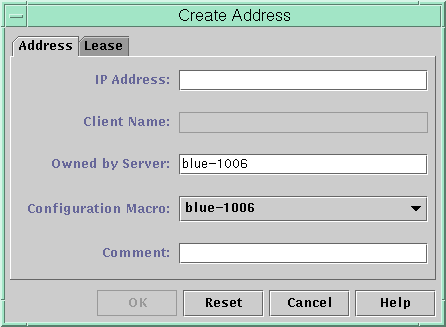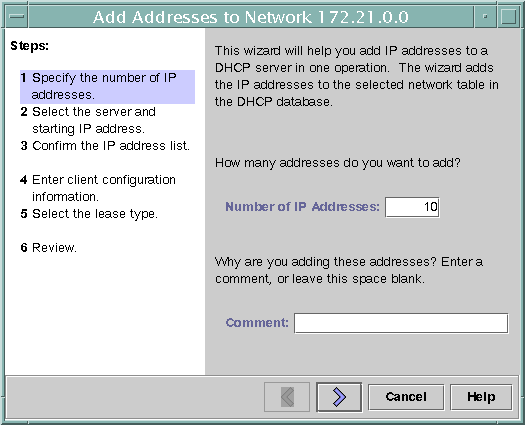 How to Set Up Support of Registered BOOTP Clients (DHCP Manager)
How to Set Up Support of Registered BOOTP Clients (DHCP Manager)
Select Modify from the Service menu.
The Modify Service Options dialog box opens.
In the BOOTP Compatibility section of the dialog box, select Manual.
Select Restart Server if it is not already selected.
Click OK.
Select the Addresses tab in DHCP Manager.
Select an address you want to assign to a particular BOOTP client.
Choose Properties from the Edit menu.
The Address Properties dialog box opens.
Select the Lease tab.
In the Client ID field, type the client's identifier.
For a BOOTP client that runs the Solaris operating environment on an Ethernet network, the client ID is a string derived from the client's hexadecimal Ethernet address, preceded by the Address Resolution Protocol (ARP) type for Ethernet (01). For example, a BOOTP client having the Ethernet address 8:0:20:94:12:1e would use the client ID 0108002094121E.
Tip - As superuser on a Solaris client system, type the following command to obtain the Ethernet address for the interface:
ifconfig -a
Select Reserved to reserve the IP address for this client.
Select Assign Only to BOOTP Clients.
Click OK.
In the Addresses tab, BOOTP is displayed in the Status field, and the client ID you entered is listed in the Client ID field.
Working With IP Addresses in the DHCP Service (Task Map)
You can use DHCP Manager or the pntadm command to add IP addresses, modify their properties, and remove them from the DHCP service. Before you work with IP addresses, you should refer to Table 10-2 to become familiar with IP address properties. The table provides information for users of DHCP Manager and pntadm.
Note - This section does not include procedures for using the pntadm command. However Table 10-2 includes examples of using pntadm to specify IP address properties while adding and modifying IP addresses. Also refer to the pntadm man page for more information about pntadm.
The following task map lists tasks you must perform to add, modify, remove IP addresses and the procedures used to carry them out.
Task | Description | Instructions |
|---|---|---|
Add single or multiple IP addresses to DHCP service. | Add IP addresses on networks that are already managed by the DHCP service by using DHCP Manager. | "How to Add a Single IP Address (DHCP Manager)" "How to Duplicate an Existing IP Address (DHCP Manager)" |
Change properties of an IP address. | Change any of the IP address properties described in Table 10-2. | |
Remove IP addresses from DHCP service. | Prevent the use of specified IP addresses by DHCP. | "How to Mark Addresses Unusable (DHCP Manager)" "How to Mark Addresses Unusable (pntadm)" "How to Delete IP Addresses from DHCP Service (DHCP Manager)" |
Assign consistent address to a DHCP client. | Set up a client to receive the same IP address each time it requests its configuration. | "How to Assign a Consistent IP Address to a DHCP Client (DHCP Manager)" "How to Assign a Consistent IP Address to a DHCP Client (pntadm)" |
The following table lists and describes the properties of IP addresses.
Table 10-2 IP Address Properties
Property | Description | How to Specify in pntadm Command |
|---|---|---|
Network address | Address of the network that contains the IP address you are working with. The network address is displayed in the Networks list on the Addresses tab in DHCP Manager.
| The network address must be the last argument on the pntadm command line used to create, modify, or delete an IP address. For example, to add an IP address to network 10.21.0.0 pntadm -A ip-address options 10.21.0.0 |
IP address | Address you are working with, whether you are creating, modifying, or deleting it. The IP address is displayed in the first column of the DHCP Manager's Addresses tab. | The IP address must accompany the -A, -M, and -D options to the pntadm command. For example, to modify IP address 10.21.5.12 pntadm -M 10.21.5.12 options 10.21.0.0 |
Client name | Host name mapped to the IP address in the hosts table. This name may be automatically generated by DHCP Manager when addresses are created. If you create a single address, you can supply the name. | Specify the client name with the -h option. For example, to specify client name carrot12 for 10.21.5.12: pntadm -M 10.21.5.12 -h carrot12 10.21.0.0 |
Owning server | DHCP server that manages the IP address and is responsible for responding to the DHCP client's request for IP address allocation. | Specify the owning server name with the -s option. For example to specify server blue2 to own 10.21.5.12: pntadm -M 10.21.5.12 -s blue2 10.21.0.0 |
Configuration macro | Macro the DHCP server uses to obtain network configuration options from the dhcptab. Several macros are created automatically when you configure a server and add networks. See "About Macros" for more information about macros. When DHCP Manager creates addresses, it creates a server macro and assigns that macro as the configuration macro for each address. | Specify the macro name with the -m option. For example, to assign the server macro blue2 to address 10.21.5.12 pntadm -M 10.21.5.12 -m blue2 10.21.0.0 |
Client ID | Text string that is unique within the DHCP service. If the client ID is listed as 00, the address is not allocated to any client. If you specify a client ID when modifying the properties of an IP address, you manually bind the address to that client for its exclusive use. The client ID is determined by the vendor of the DHCP client. If your client is not a Solaris DHCP client, consult your DHCP client documentation for more information. | Specify the client ID with the -i option. For example, to assign client ID 08002094121E to address 10.21.5.12 pntadm -M 10.21.5.12 -i 0108002094121E 10.21.0.0 |
| For Solaris DHCP clients, the client ID is derived from the client's hexadecimal hardware address, preceded by the ARP code for the type of network, such as 01 for Ethernet. The ARP codes are assigned by the Internet Assigned Numbers Authority (IANA) in the ARP Parameters section of the Assigned Numbers standard at http://www.iana.com/numbers.html For example, a Solaris client with the hexadecimal Ethernet address 8:0:20:94:12:1e would use the client ID 0108002094121E. The client ID is listed in DHCP Manager and pntadm when a client is currently using an address. Tip: As superuser on the Solaris client system, type the following command to obtain the Ethernet address for the interface: ifconfig -a |
|
Reserved | The setting that specifies the address is reserved exclusively for the client indicated by the client ID, and the DHCP server cannot reclaim the address. If you choose this option, you manually assign the address to the client. | Specify that the address is reserved, or manual, with the -f option. For example, to specify that IP address 10.21.5.12 is reserved for a client: pntadm -M 10.21.5.12 -f MANUAL 10.21.0.0 |
Lease type/policy | The setting that determines how DHCP manages the use of the IP address by clients. A lease may be dynamic or permanent. See "Dynamic and Permanent Lease Type" for a complete explanation. | Specify that the address would be permanently assigned with the -f option. Addresses are dynamically leased by default. For example, to specify that IP address 10.21.5.12 has a permanent lease: pntadm -M 10.21.5.12 -f PERMANENT 10.21.0.0 |
Lease expiration time | Date and time when the lease expires, applicable only when a dynamic lease is specified. The date is specified in mm/dd/yyyy format. | Specify an absolute lease expiration time with -e. For example, to specify an expiration time of January 1, 2002: pntadm -M 10.21.5.12 -e 01/01/2002 10.21.0.0 |
BOOTP setting | The setting that marks the address as reserved for BOOTP clients. See "Supporting BOOTP Clients with DHCP Service (Task Map)" for more information about supporting BOOTP clients. | Reserve an address for BOOTP clients with -f. For example, to reserve IP address 10.21.5.12 for BOOTP clients: pntadm -M 10.21.5.12 -f BOOTP 10.21.0.0 |
Unusable setting | The setting that marks the address so it cannot be assigned to any client. | Mark an address unusable with -f. For example, to mark IP address 10.21.5.12 unusable: pntadm -M 10.21.5.12 -f UNUSABLE 10.21.0.0 |
Adding Addresses to the DHCP Service
Before you add addresses, you must add the network that owns them to the DHCP service. See "Adding DHCP Networks" for information about adding networks.
You can add addresses with DHCP Manager or pntadm.
On networks that are already managed by the DHCP service, you can add addresses in several ways with DHCP Manager:
Add a single IP address - Place one new IP address under DHCP management.
Duplicate an existing IP address - Copy the properties of an existing IP address managed by DHCP, and supply a new IP address and client name.
Add a range of multiple IP addresses - Use the Address Wizard to place a series of IP addresses under DHCP management.
The following figure shows the Create Address dialog box. The Duplicate Address dialog box is identical to the Create Address dialog box, except that the text fields display the values for an existing address.
Figure 10-8 Create Address Dialog Box

The following figure shows the first dialog of the Address Wizard, used to add a range of IP addresses.
Figure 10-9 Address Wizard

 How to Add a Single IP Address (DHCP Manager)
How to Add a Single IP Address (DHCP Manager)
Select the Addresses tab.
Select the network where the new IP address is to be added.
Choose Create from the Edit menu.
The Create Address dialog box opens.
Select or type values for the address settings on the Address and Lease tabs.
See Table 10-2 for information about the settings.
Click OK.
 How to Duplicate an Existing IP Address (DHCP Manager)
How to Duplicate an Existing IP Address (DHCP Manager)
Select the Addresses tab.
Select the network where the new IP address is located.
Select the address whose properties you want to duplicate.
Choose Duplicate from the Edit menu.
Change the IP address and client name for the address.
Most other options should remain the same, but you can change them if necessary.
Click OK.




